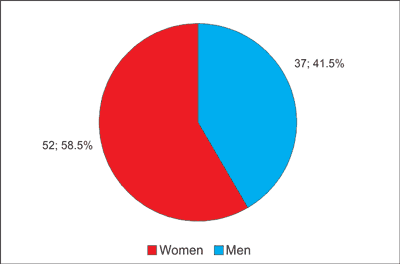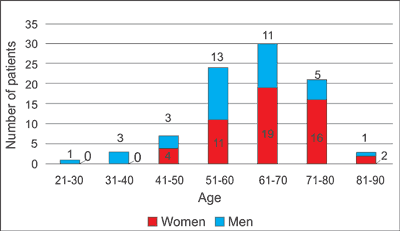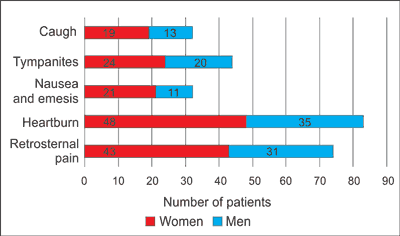Hady Razak Hady1, *Patrycja Pawluszewicz1, Mikolaj Czerniawski1, Maria Niebrzydowska2, Pawel Wojciak1, Piotr Golaszewski1, Agnieszka Swidnicka-Siergiejko3, Safauldeen Salim Neamah4, Paulina Wozniewska1, Anna Gromotowicz-Poplawska5, Jacek Dadan1
Management of patients with hiatal hernia in own material
Postępowanie z pacjentami z przepukliną przeponową w materiale własnym
1Ist Department of General and Endocrine Surgery, Medical University of Bialystok, Poland
2Department of Surgery, Hospital in Lapy, Poland
3Department of Gastroenterology and Internal Medicine, Medical University of Bialystok, Poland
4Department of General Surgery, College of Medicine, University of Kufa, Iraq
5Department of Biopharmacy, Medical University of Bialystok, Poland
Streszczenie
Wstęp. Przepukliny rozworu przełykowego są częstą patologią, w szczególności u osób w starszym wieku. Najczęściej mamy do czynienia z przepukliną wślizgową oraz okołoprzełykową. W większości przypadków są bezobjawowe lub dają niespecyficzne dolegliwości. Przepukliny przeponowe często wiążą się z refluksem żołądkowo-przełykowym (GERD).
Cel pracy. Celem pracy było przeanalizowanie zgłaszanych dolegliwości, diagnostyki, rodzaju przepuklin przeponowych, współwystępowania GERD oraz rodzaju przeprowadzonej operacji plastyki przepukliny rozworu przełykowego.
Materiał i metody. Ocenie retrospektywnej zostało poddanych 89 chorych (średnia wieku 59,5 roku; 52 kobiety, 37 mężczyzn) operowanych z powodu przepuklin rozworu przełykowego w I Klinice Chirurgii Ogólnej i Endokrynologicznej USK w Białymstoku oraz na Oddziale Chirurgii w Łapach w latach 2012-2017.
Wyniki. W badanym materiale stwierdzono 53 przypadki (59%) przepuklin wślizgowych, 29 przypadków (33%) przepuklin mieszanych oraz okołoprzełykowe u 7 chorych (8%).
Wnioski. Laparoskopowa naprawa przepukliny rozworu przełykowego z jednoczasową fundoplikacją jest skuteczną i bezpieczną opcją terapeutyczną do leczenia przepukliny rozworu przełykowego, zapobiegania nawrotom i łagodzenia objawów GERD. Wyniki są trwałe, a odsetek powikłań jest bardzo niski.
Summary
Introduction. Hiatal hernia is a common pathology, especially in older people. The most frequently observed types are sliding hiatal hernia and paraesophageal hernia. The majority of cases are asymptomatic or give nonspecific symptoms. Diaphragmatic hernias are often associated with gastroesophageal reflux (GERD).
Aim. The aim of the study was to analyze reported ailments, diagnostics, type of diaphragmatic hernia, coexistence of GERD and the type of surgery performed due to hiatal hernia.
Material and methods. Retrospective analysis included 89 patients (average age – 59.5, 52 women, 37 men) after the surgery of hiatal hernia in Ist Department of General and Endocrinological Surgery, University Hospital in Bialystok and the Department of Surgery in Lapy in the years 2012-2017.
Results. 53 cases (59%) of hiatal hernias have been observed in examined material, 29 cases (33%) of mixed hernias and paraoesophageal hernias in 7 patients (8%).
Conclusions. Laparoscopic repair of hiatal hernia with simultaneous fundoplication is an effective and safe therapeutic option for the treatment of hiatal hernia, prevention of remissions and alleviation of GERD symptoms. The results are permanent and the complication rate is very low.

Introduction
The frequency of hiatal hernia occurrence increases along with age. Clinical observations indicate that approximately 50-60% of people over 50 years old have an esophageal hernia (1-4). The majority patients report no symptoms, which is why they are often unrecognized. Four types of hiatal hernia are distinguished: sliding hernia and the paraoesophageal hernia, mixed hernia and diaphragmatic hernia with congenital short esophagus. Sliding hernia is definitely the most common and is very often associated with gastroesophageal reflux disease, it occurs when the cardia is relocated to the thorax with part of the stomach (5). The mechanism of paraoesophageal hernia creation includes relocation of the fundus through the defect in the diaphragm to the thorax, and the cardia remains unchanged in the abdominal cavity.
Patients with diaphragmatic hernia, usually asymptomatic, may report a variety of symptoms, such as chest pain, shortness of breath, reflexes, heartburn, recurrent pneumonia, hoarseness, chronic cough, iron deficiency anemia. None of the symptoms is pathognomic for hiatal hernia, so patients go a long way before the correct diagnosis and proper treatment is implemented (6). Among the risk factors that increase the frequency of diaphragmatic hernias include: male gender, obesity and increasing age as well as increased secretion of hydrochloric acid in the stomach (4).
The surgery is necessary for a hiatal hernia with GERD and a paraoesophageal hernia due to the high risk of complications. However, the perioperative risk of elderly patients and multiple co-morbidities should be considered in cases where treatment with proton pump inhibitors brings relief (7). Repair surgery of hiatal hernia includes relocating the contents of the hernia back to the abdominal cavity, dissecting the hernia sac and removing it. The next stage of the surgery is supplying diaphragm defect with surrounding tissues or synthetic meshes. What is more, a fundoplication around the abdominal part of the esophagus is performed by applying 2-3 seams to open the antireflux barrier and keep the stomach below the diaphragm (8).
Aim
The aim of the study was to analyze the reported complaints, diagnostics, type of diaphragmatic hernias, coexistence of GERD and the type of hiatal hernia surgery performed.
Material and methods
Eighty nine patients have been examined operated due to hiatal hernia by one team of surgeons in the Ist Department of General and Endocrinological Surgery, University Hospital in Bialystok and the Department of Surgery in Lapy between 2012 and 2017. The group of respondents included 37 men (41.5%) and 52 women (58.5%) with an average age of 59.5 (tab. 1, fig. 1).
Tab. 1. The number of patients after the surgery due to hiatal hernia
| | Number | % | Average age |
| Women | 52 | 58.4 | 61.5 |
| Men | 37 | 41.6 | 56.9 |
| Total | 89 | | 59.5 |

Fig. 1. The gender of patients
Results
Patients operated due to hiatal hernia were between 26 and 81 years old. The average age among men was 56.9, and among women 61.5. Most often, women aged 61-80 were operated and men 51-70 years old (tab. 2, fig. 2).
Tab. 2. Distribution of patients due to age
| | 21-30 | 31-40 | 41-50 | 51-60 | 61-70 | 71-80 | 81-90 |
| | n | % | n | % | n | % | n | % | n | % | n | % | n | % |
| F (52) | – | – | – | – | 4 | 7.7 | 11 | 21.2 | 19 | 36.5 | 16 | 30.8 | 2 | 3.8 |
| M (37) | 1 | 2.7 | 3 | 8.1 | 3 | 8.1 | 13 | 35.2 | 11 | 29.7 | 5 | 13.5 | 1 | 2.7 |
| Total | 1 | 1.1 | 3 | 3.4 | 7 | 7.9 | 24 | 26.9 | 30 | 33.7 | 21 | 23.6 | 3 | 3.4 |

Fig. 2. Distribution of patients due to age
Patients reporting many symptoms, most often suffered from retrosternal pains, heartburn, nausea, vomiting, flatulence and cough (tab. 3, fig. 3).
Tab. 3. Reported symptoms
| | Women | Men | Total |
| n | % | n | % | n | % |
| Retrosternal pain | 43 | 82.7 | 31 | 83.8 | 74 | 83.1 |
| Heartburn | 48 | 92.3 | 35 | 94.6 | 83 | 93.3 |
| Nausea and emesis | 21 | 40.4 | 11 | 29.7 | 32 | 36.0 |
| Tympanites | 24 | 46.2 | 20 | 54.1 | 44 | 49.4 |
| Cough | 19 | 36.5 | 13 | 35.1 | 32 | 36.0 |

Fig. 3. Reported symptoms
Powyżej zamieściliśmy fragment artykułu, do którego możesz uzyskać pełny dostęp.
Mam kod dostępu
- Aby uzyskać płatny dostęp do pełnej treści powyższego artykułu albo wszystkich artykułów (w zależności od wybranej opcji), należy wprowadzić kod.
- Wprowadzając kod, akceptują Państwo treść Regulaminu oraz potwierdzają zapoznanie się z nim.
- Aby kupić kod proszę skorzystać z jednej z poniższych opcji.
Opcja #1
29 zł
Wybieram
- dostęp do tego artykułu
- dostęp na 7 dni
uzyskany kod musi być wprowadzony na stronie artykułu, do którego został wykupiony
Opcja #2
69 zł
Wybieram
- dostęp do tego i pozostałych ponad 7000 artykułów
- dostęp na 30 dni
- najpopularniejsza opcja
Opcja #3
129 zł
Wybieram
- dostęp do tego i pozostałych ponad 7000 artykułów
- dostęp na 90 dni
- oszczędzasz 78 zł
Piśmiennictwo
1. Mittal RK: Hiatal hernia: myth or reality? Am J Med 1997; 103: 33S-39S.
2. Luketich JD, Nason KS, Christie NA et al.: Outcomes after a decade of laparoscopic giant paraesophageal hernia repair. J Thorac Cardiovasc Surg 2010; 139: 395-404.
3. Perdikis G, Hinder RA, Walenz T et al.: Laparoscopic paraesophageal hernia repair. Arch Surg 1997; 132: 586.
4. Geha AS, Massad MG, Snow NJ et al.: A 32-year experience in 100 patients with giant paraesophageal hernia: the case for abdominal approach and selective antireflux repair. Surgery 2000; 128: 623.
5. Hyun JJ, Bak Y-T: Clinical significance of hiatal hernia. Gut and Liver 2011; 5(3): 267-277.
6. Mackiewicz A, Wojtun S, Gil J: Noncardiac chest pain. Pediatr Med Rodz 2013; 9(1): 25-31.
7. Korzonek M, Dziergas A, Kuczynska M: Gastroesophageal reflux disease – current problem. Forum Med Rodz 2014; 8(5): 201-210.
8. Yang X, Hua R, He K et al.: Laparoscopic hernioplasty of hiatal hernia. Ann Transl Med 2016; 4(18): 343.
9. Stasyshyn A: Diagnosis and treatment of gastroesophageal reflux disease complicated by Barret’s esophagus. Polish Journal of Surgery 2017; 89(4): 30-33.
10. Misiak P, Jablonski S, Piskorz L et al.: Oesophageal perforation – therapeutic and diagnostics challenge. Retrospective, single-center case report analysis (2009-2015). Polish Journal of Surgery 2017; 89(4): 1-6.
11. Imperatore K, Olivieri B, Vincentelli C: Acute gastric volvulus: a deadly but commonly forgotten complication of hiatal hernia. Autops Case Rep 2016; 6(1): 21-26.
12. Weitzendorfer M, Köhler G, Antoniou SA et al.: Preoperative diagnosis of hiatal hernia: barium swallow X-ray, high-resolution manometry, or endoscopy? Eur Surg 2017; 49(5): 210-217.
13. Bytzer P: Information bias in endoscopic assessment. Am J Gastroenterol 2007; 102: 1585-1587.
14. Johnson LF, Demeester TR, Haggitt RC: Endoscopic signs for gastroesophageal reflux objectively evaluated. Gastrointest Endosc 1976; 22: 151-155.
15. Zhang C, Hu Z-W, Yan C et al.: Nissen fundoplication vs proton pump inhibitors for laryngopharyngeal reflux based on pH-monitoring and symptom-scale. World J Gastroenterol 2017; 23(19): 3546-3555.
16. Lebenthal A, Waterford SD, Fisichella PM: Treatment and controversies in paraesophageal hernia repair. Front Surg 2015; 2(13): 1-6.
17. Du X, Hu Z, Yan C et al.: A meta-analysis of long follow-up outcomes of laparoscopic Nissen (total) versus Toupet (270°) fundoplication for gastro-esophageal reflux disease based on randomized controlled trials in adults. BMC Gastroenterology 2016; 16(88): 1-11.
18. Marano L, Schettino M, Porfidia M et al.: The laparoscopic hiatoplasty with antireflux surgery is a safe and effective procedure to repair giant hiatal hernia. BMC Surgery 2014; 14(1): 1-9.
19. Chang CG, Thackeray L: Laparoscopic hiatal hernia repair in 221 patients: outcomes and experience. JSLS 2016; 20(1): 1-7.
20. Higashi S, Nakajima K, Tanaka K et al.: Laparoscopic anterior gastropexy for type III/IV hiatal hernia in elderly patients. Surgical Case Reports 2017; 3(45): 1-6.
21. Larusson HJ, Zingg U, Hahnloser D et al.: Predictive factors for morbidity and mortality in patients undergoing laparoscopic paraesophageal hernia repair: age, ASA score and operation type influence morbidity. World J Surg 2009; 33(5): 980-985.



